Peru, Bolivia, Chile, Argentina & Brazil
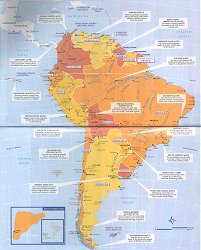 |
Peru
Peru, Bolivia, Chile, Argentina & Brazil
 |
Peru
South America is a huge continent of which we saw highlights of 5 countries. We started in Peru, in Lima after a long flight from Amsterdam via Madrid. Madrid has a very large airport that consists of two buildings. Some distances can take up to 25 minutes of walking, so be prepared.
Lima is a very busy city, has a huge traffic jam, but also nice places like Parque del Amor, Plaza Mayor and the very fine shopping and restaurant centre Larcomar in Miraflores, a very central area of Lima near the coast.
After a short stay in Lima we went by bus over the Pan-American Highway through the sandy dessert, partly along the Pacific coast, to Ica, the wine capital of Peru. The Hotel Las Dunas is a very nice hotel with many patios and bungalows, it has a great swimming pool, a nice restaurant and is very conveniently located for a visit to the Ica museum, a buggy ride over the dunes nearby or a flight over the Nazca lines. These lines were very difficult to spot for us, though after a closer look at the pictures we found some of them near the tower.
On our way back to Lima we visited the Ballestas Islands near Paracas peninsula. These islands are a good and somewhat cheaper alternative for the Galapagos Islands. The boat first passed a huge stone gravure, the Candelabra. It is unknown who made it or why. On the islands are many, many birds, Humboldt penguins, sea lions and guano. Every 7 to 8 years the guano is picked by hand to be used and sold as fertilizer. What a job!
Sacred valley, Machu Picchu & Cusco
Our three days tour through the Sacred Valley of the Incas and Machu Picchu started in Cusco at 08.20 hours, so we had to take a very early flight (05.10 hours) from Lima to be on time in Cusco (aka Cuzco). Be aware that only five kg luggage per person is allowed in the train to Machu Picchu and therefore it is wise, if possible, to repack e.g. in the hotel in Cusco where you will stay later and to take a smaller backpack with you on this trip.
We made some stops to enjoy a little market, the view over the valley and to see some of the local animals like lamas and alpacas. Both species as well as the family of the smaller vicuñas belong to the family of the Camelidae.
Other stops were at the colourful Indian market in Pisac, lunch in Urubamba in a former old hacienda with life music and a visit to the beautiful Inca fortress in Ollantaytambo, a small village laid between the mountains of the Andes.
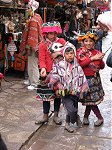 |
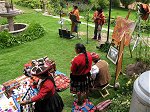 |
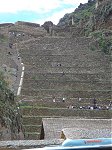 |
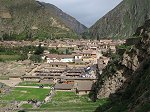 |
The next day the train from Ollantaytambo brought us to Aguas Calientes, the village close to Machu Picchu. From here by bus over a very steep dirt road to this long time undiscovered Inca city. Even during rain or fog the ruins are mysterious and stunning.
Yes, it was a big shock for us three or four days after our visit, when we heard about the landslide near Machu Picchu and the damage to the train station in Aguas Calientes. When Aguas Calientes and Machu Picchu can be visited again, hopefully in early April 2010, try to reach at least the viewpoint not too far away from the entrance of Machu Picchu, even if you are slightly handicapped in walking, like Jaap is. From here you have the above views on the ruins. The viewpoint is at the right picture very much to the left.
Some pictures of how it was in Aguas Calientes before the disaster occurred. We hope that these restaurants are still there and we wish everyone all the best. The river on the picture is not the Urubamba river, but see how it whirls. The bigger Urubamba river at the back of the picture is even worse.
Cusco is a very lovely place with nice houses with arcades and wooden balconies, a beautiful Plaza de Armas with many flowers and the large cathedral. Be careful when booking a city tour. Our tour only took us to the cathedral, the Santo Domingo monastery and the Inca ruins outside the town, but didn't go through the city itself. So we skipped the outside part and walked through and enjoyed the narrow streets of Cusco.
It is a long 10 hours journey by bus from Cusco to Puno at the Peruvian side of Lake Titicaca. Luckily during this trip we made some stops at interesting places like the old Inca ruins of Raqchi.
And after lunch we stopped at the highest pass of this tour, 4,335 metres. Here we had nice views on the high Andes. Have a look at the difference in clothes. Some people wear their Peruvian hats, others are dressed in Bolivian style clothes.
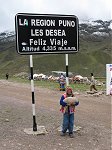 |
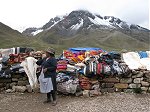 |
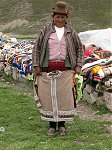 |
In Puno we stayed in the beautiful hotel Sonesta Posadas del Inca where we had a nice room with a view on the lake. From the harbour a motorboat brought us over the lake to the floating Uros islands. The Uros people not only make these islands by hand, but also their houses and boats, with which they sail between the islands and also to Puno.
The weather on Lake Titicaca can vary a lot from one place to another. We had some rain on the floating islands, but the more we came to Taquile island the sunnier it was. Taquile has its own microclimate, so we were told. Lunch was served after some music and dancing in one of the family restaurants high on the island. From here we had splendid views over the island. And some time later also at the clouds hanging above Puno.
Bolivia
A small hydrofoil brought us from Copacabana in Bolivia first to Moon Island, where you can visit some ancient Inca ruins, and then to Sun Island.
To see this beautiful island you have to make a steep climb first, which was very difficult for Jaap. Luckily he didn't have to walk the remainder of the path, since a mule was waiting for him after the ascent. Accompanied by lama Martin our guide Antonio and I walked to our hotel Posada del Inca Eco lodge. From here again the views over the lake are stunning. Sun Island gets more and more tourists and therefore almost every house on the island is a hotel, restaurant or souvenir shop.
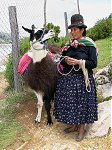 |
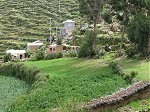 |
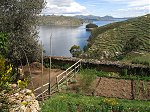 |
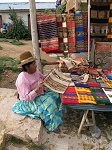 |
The next day was a rainy day, contrary to the first day when the sun was shining and the temperature was nice in spite of the fact that Sun island is at an altitude of around 4,000 metres. And although the descent was over a different somewhat wider path it was hard again. But hand in hand and with lots of laughs we came down.
Through the narrow strait between the two parts of Lake Titicaca and over the smaller part we sailed in the same hydrofoil to Huatajata. Opposite the Inca Utama hotel, where we stayed, is a small village/exposition with a replica of Thor Heyerdahl's Ra II. One of the builders of Thor's boats is Demetrio Limachi, who showed us some pictures and models of the boats. Firmin, his son, will try to sail Thor's last boat from Cairns in Australia to South America this year. There are also some lamas and alpacas in the village. Five hours before we arrived this little white alpaca was born.
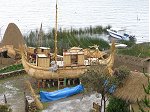 |
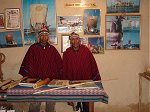 |
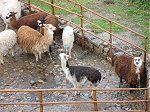 |
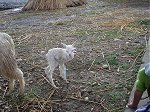 |
La Paz is one of the highest capitals in the world. It is built in a valley and the difference in altitude in approx. 1,000 metres, i.e. from above 4,000 to 3,000 metres. And if you arrive by plane you will arrive at the highest part :-) Streets in the old parts like the Spanish quarter or the area around San Francisco cathedral are very narrow and of course very steep.
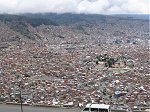 |
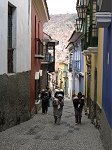 |
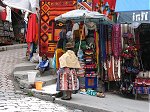 |
La Paz "Plaza de Armas" is called Plaza Pedro D. Murillo and has many important buildings e.g. the presidential palace and the cathedral and it also has many pigeons. Many women wear very specific Bolivian dresses and hats.
Chile
After the previous days in the high Andes it was nice to have warm weather again in Santiago at approx. 700 metres above sea level and to have a drink at the Plaza de Armas, to see the people and the cathedral and young children who love to take a bath in the fountain.
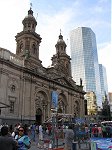 |
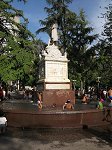 |
The next day we made a city tour and saw e.g. the central fish and fruit market, the Spanish fortress and we drove uphill San Cristobal to have a nice view over the city.
From Santiago we flew to Puerto Montt and drove to Puerto Varas. From our hotel Cabañas del Lago we could see very well the Osorno and Tronador volcanoes, Lake Llanquihue and the village itself, which looks a bit like a German village, which is not surprising since in the 19th century many Germans emigrated to this part of Chile to make a better living.
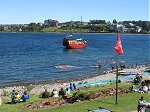 |
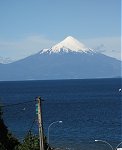 |
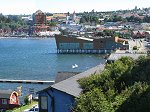 |
An even better look on the four volcanoes of this area we had at the Petrohue falls in the National Park (NP) Vincente Peréz Rosales and from the Lago Todos los Santos when we were on our tour to Peulla.
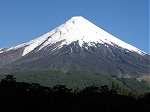 |
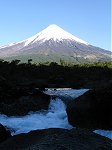 |
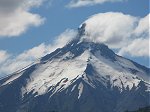 |
Peulla is a little village with 120 inhabitants (3 cats and a dog) near the border with Argentina, which you can cross here by alternatively using a bus, boat, bus, boat and bus all the way to Bariloche. Unfortunately, we didn't do that. We made a tour by 4WD truck, crossed the Peulla River and sailed the Rio Negro. After lunch we went back to Puerto Varas.
As mentioned before we didn't go by bus, boat, bus etc. to Argentina. Our transfer was by private car via Frutillar, the city of Osorno and over a more northern pass along Mirror Lake to Bariloche.
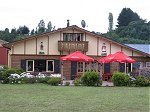 |
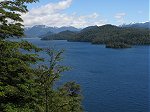 |
Bariloche is a North-Patagonian city with a lot of wind, a funny plaza and a lovely and famous chocolate shop, Mammushka, in the main street Mitre. Of course we bought some chocolates there too. If the ATM in Mitre Street doesn't work or is too busy, there is another one just one street north which might be handy if you are short of money.
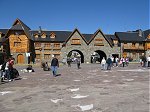 |
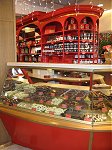 |
The tour to the Cerro de Tronador goes over dirt roads along Lago Guitierrez and Lago Mascardi to the black glacier of the Tronador. The name Tronador comes from the avalanches that thunder down the mountain and are loud enough to be heard through the NP Nahuel Huapi. A year or so ago the water of the lagoon in front of the glacier broke through its natural dam and the power of the water almost destroyed the village of Pampa Linda. Now the level of the glacier is much lower. In the last 30 years the glacier also moved back considerably. And there is not only the black glacier, but there are also white glaciers and many waterfalls.
With a three hours delay we arrived in Buenos Aires around 6 o'clock in the evening and we had only time to walk around a bit and watch the landmark of the city, i.e. the obelisk and to eat one of those famous Argentine steaks; they weighed more than 300 grams each. We had never thought that we would be able to eat such a large piece of meat, but it was so delicious that we managed. It really was the best steak we ever had in our lives.
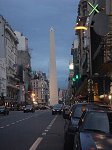 |
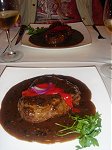 |
The next day the city tour brought us via San Telmo first to the Plaza de Mayo. Every week mothers and grandmothers still come here to mourn and ask about their disappeared family. The obelisk at this square is their gathering point.
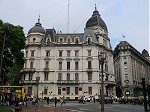 |
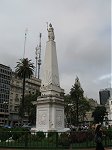 |
Our next stop was in La Boca, another part of Buenos Aires. Soccer fans can visit the La Boca Juniores soccer stadium. And for all of us there is the artists street Caminito. It is only 100 metres long, but most likely every tourist will come here to see the colourful houses. If you like you can have a picture taken of you and a tango dancer.
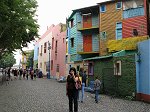 |
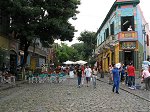 |
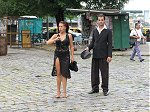 |
The bus took us along the harbours of La Boca and Puerto Madero with its renovated docks, through Palermo with its parks to Recoleta, where our crown princess Máxima grew up. Recoleta is Buenos Aires' wealthiest neighbourhood. Here is also the cemetery where you can find Eva Peron's (Evita) mausoleum. After a visit we went back to the obelisk, now by daylight. It stands on the world's broadest avenue, Avenida 9 de Julio. Be careful when crossing! It would be nice to have such avenues in Amsterdam too :-)
Since our flight from Buenos Aires to Puerto Iguazu, still in Argentina, was in the afternoon we had no time that day to go to the falls. We went straight to our hotel in Foz do Iguaçu on the Brazilian side. It was very warm and it was wonderful to take a dive in the also warm swimming pool of our hotel Rafain Palace. A cool beer was very welcome.
The waterfalls are on both sides of the border between Argentina and Brazil. It is best to see both sides and we can't say which side we prefer. On the Argentine side is the huge Garganta del Diablo. After two train rides that take quite some time, you have a long walk over a narrow trail. The water is thundering down and if the wind is from the wrong direction you will become very wet. Never mind, it is great to see the Garganta and with temperatures of 40 degrees centigrade it is not so bad to become wet.
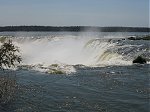 |
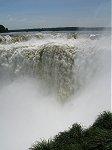 |
At the Brazilian side you will get a better view over the large number of falls. And from the low bridge, where you will get wet too, you will see the Garganta again and the many other falls.
At the end of the road, near the restaurants, is another big waterfall. Here is also an elevator that brings you down and very close to the fall. You can almost touch the water and it makes so much noise that you can hardly understand each other.
Our hotel in Rio de Janeiro was only one block away from Copacabana Beach. The beach is very large and the sea is fine, but be careful, don't go on the beach at night. At daytime, however, it is safe and it is a nice place to sit and watch.
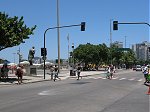 |
If you haven't much time in Rio de Janeiro two places that you must see are the statue of Christ the Redeemer and the Sugar Loaf, a nice hill in the middle of the city. Christ the Redeemer can be reached by cable car, elevator and escalators, so very easy to visit. From the top you have very nice views over the city.
The Sugar Loaf is less easy to be reached. The first part is by two gondolas. At the top, however, you have to climb quite some stairs. But the views are great again, e.g. on Copacabana Beach.
Buzios was the last place that we would visit this holiday. We stayed in the very nice hotel Rio Buzios, near the João Fernandes Beach. It was nice to relax a few days after four wonderful, but busy weeks.
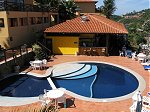 |
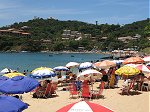 |
It was a very easy going time in which we made a nice schooner tour. No, not with that big cruise ship, but with one of the smaller boats. We sailed, swam and an even smaller boat brought us very tasty gambas to eat. After the tour we walked through the village which is both at day and at night very nice.